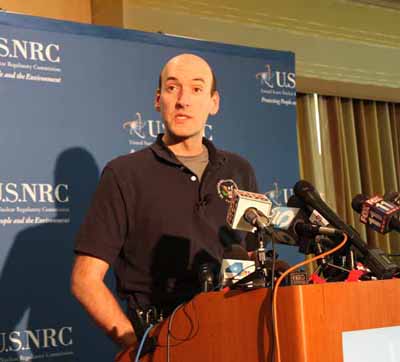Unexpected steam generator tube wear that prompted the indefinite shutdown of Southern California Edison’s (SCE’s) San Onofre Nuclear Generating Station (SONGS) in January was caused by excessive tube vibration, company executives confirmed at a community meeting on Monday. Officials from the Nuclear Regulatory Commission (NRC) meanwhile pinned the tube failures on a flawed computer model used to design the steam generator components.
On Monday evening in San Juan Capistrano, in the first of a series of public meetings hosted by the NRC, SCE said it had completed more than 60,000 tests on SONGS Unit 2 and 3 and performed significant analysis of the test results. Executives concluded the cause of the unexpected tube-to-tube wear is "fluid elastic instability," which had in turn caused excessive tube vibration. Most excessive wear occurred in a limited area of Unit 3 steam generators and was due to "high steam flow velocities, very dry steam, and inadequate tube support structure in the U-bend region for the tubes experiencing the wear."
Greg Werner, the NRC’s regional plant support branch chief, reportedly pointed to a flawed computer model used by Mitsubishi Heavy Industries (MHI), the steam generator manufacturer, as the reason too much steam may have flowed through the steam generators, causing the unusual tube wear. The NRC had run its own computer model and found a major design discrepancy, Werner reportedly said.
"We detected that the computer simulation used [by MHI] to design the steam generators had under-predicted the velocities of steam water inside the steam generators by factors of two to three times," San Diego newspaper The North County Times quoted Werner as saying.
Werner also reportedly said that anti-vibration bars to hold the tubes in Unit 3 together were looser than they should be, allowing the tubes to rub against each other and causing premature wear. Additionally, tubes inside one of the Unit 3 generators may have not been properly supported during shipping from Japan, where they were built. All three accelerometers registered "an excessive force, which could indicate mishandling during the transportation of the steam generators," Werner reportedly said.
Elmo Collins, regional administrator for the NRC’s Region IV office, "made it clear that it’s Southern California Edison that will ultimately be held accountable if penalties are eventually levied by the government," Reuters reported.
The twin-reactor plant’s Unit 2 has been shut down since Jan. 9 for a planned refueling and maintenance outage; SCE operators performed a rapid shutdown of Unit 3 on Jan. 31 after a leak was detected at one of that unit’s steam generator tubes. Subsequent testing by SCE showed that though only one tube required pressure testing on Unit 2, six other tubes required plugging and another 186 tubes were plugged as a precautionary measure. Meanwhile, at Unit 3, eight tubes failed pressure testing.
For both units, this was the first cycle of operation with new replacement steam generators from MHI that cost $671 million: Unit 2 replaced its steam generators in January 2010 and Unit 3 in January 2011. Each steam generator has 9,727 steam generator tubes, and the new equipment is intended to last until the plant’s license expires in 2022.
“The top priority of Mitsubishi is the safe and reliable operation of all the plants and components we design, engineer and support. The steam generators in Units 2 and 3 at San Onofre were designed in line with our customer’s specific needs and with customer input, using the best-available data and established industry standards," MHI said in a statement e-mailed to POWERnews.
"The NRC’s observation as reported at the meeting was preliminary, and we are committed to continue supporting our customer, SCE, in working with the NRC to complete the investigation and to implement solutions to resolve the issue as quickly as possible.”
Officials of the NRC declined to provide a specific timeline for restarting the 2,200-MW plant. The California Independent System Operator has said that if the plant remains offline through the summer, San Diego and portions of Los Angeles Basin may face local reliability challenges.
SCE on Monday said it would address a number of "outstanding issues," including following up on any remaining information requests from the NRC’s inspection team for completion of inspection activities, and to work with MHI and other steam generator vendors to determine intermediate and long-term solutions to the problem.
Sources: POWERnews, SCE, NRC, The North County Times, Reuters
—Sonal Patel, Senior Writer, (@POWERmagazine)








